通用汽车公司资料
- 格式:ppt
- 大小:6.47 MB
- 文档页数:31
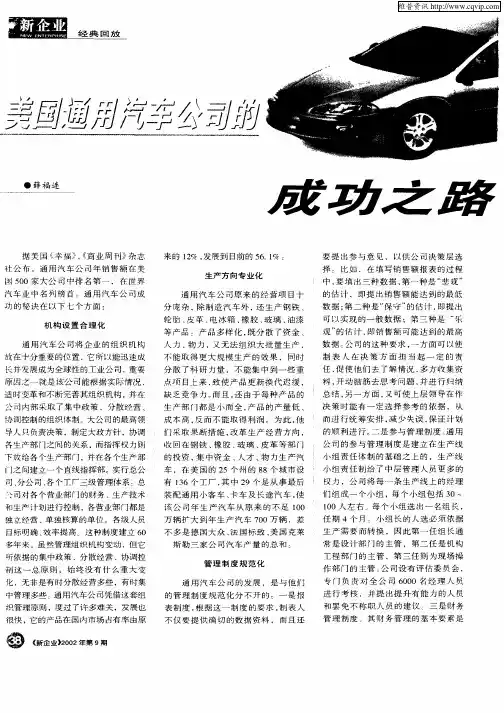
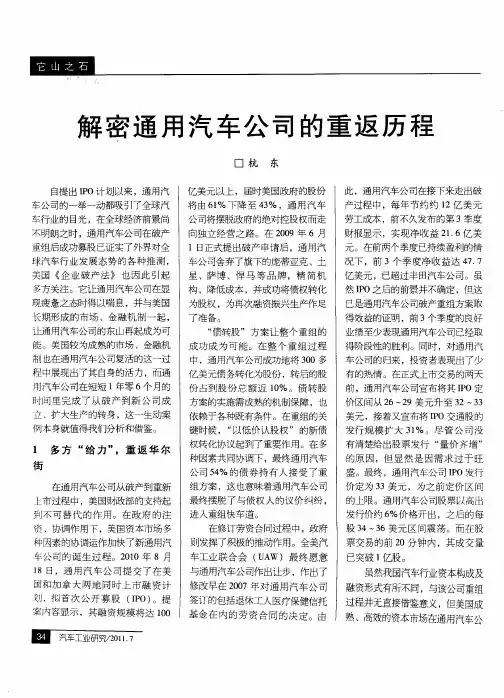
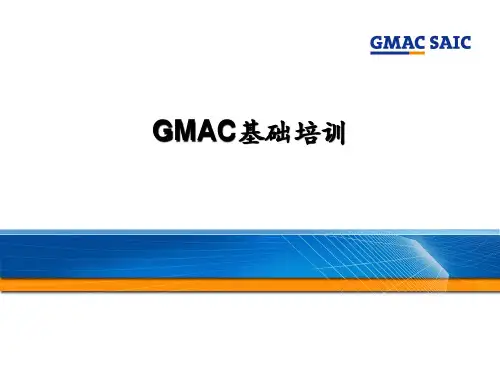
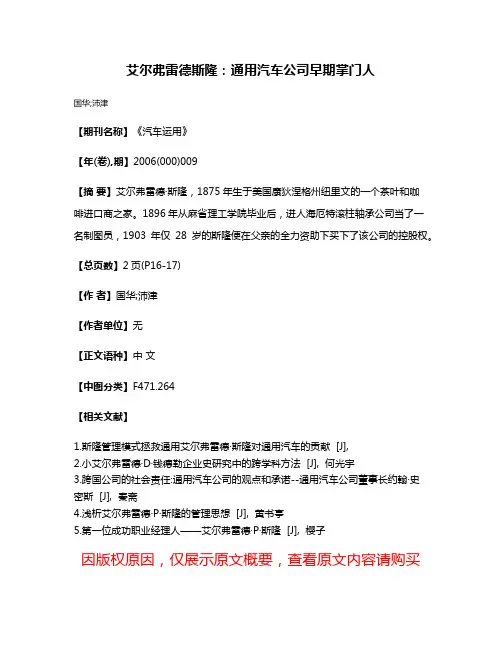
艾尔弗雷德斯隆:通用汽车公司早期掌门人
国华;沛津
【期刊名称】《汽车运用》
【年(卷),期】2006(000)009
【摘要】艾尔弗雷德·斯隆,1875年生于美国康狄涅格州纽里文的一个茶叶和咖
啡进口商之家。
1896年从麻省理工学院毕业后,进人海厄特滚柱轴承公司当了一名制图员,1903年仅28岁的斯隆便在父亲的全力资助下买下了该公司的控股权。
【总页数】2页(P16-17)
【作者】国华;沛津
【作者单位】无
【正文语种】中文
【中图分类】F471.264
【相关文献】
1.斯隆管理模式拯救通用艾尔弗雷德·斯隆对通用汽车的贡献 [J],
2.小艾尔弗雷德·D·钱德勒企业史研究中的跨学科方法 [J], 何光宇
3.跨国公司的社会责任:通用汽车公司的观点和承诺--通用汽车公司董事长约翰·史
密斯 [J], 秦斋
4.浅析艾尔弗雷德·P·斯隆的管理思想 [J], 黄书亭
5.第一位成功职业经理人——艾尔弗雷德·P·斯隆 [J], 樱子
因版权原因,仅展示原文概要,查看原文内容请购买。
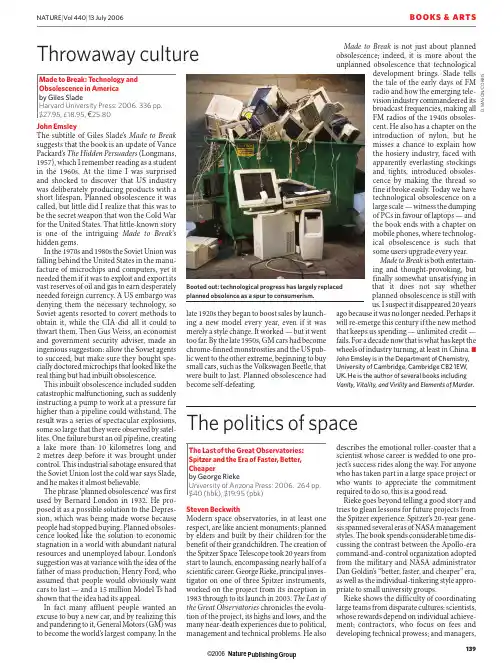
NATURE |V ol 440|13 July 2006BOOKS & ARTS139late 1920s they began to boost sales by launch-ing a new model every year, even if it was merely a style change. It worked — but it went too far. By the late 1950s, GM cars had become chrome-finned monstrosities and the US pub-lic went to the other extreme, beginning to buy small cars, such as the Volkswagen Beetle, that were built to last. Planned obsolescence had become self-defeating.is not just about planned development brings. Slade tells the tale of the early days of FMradio and how the emerging tele-vision industry commandeered its broadcast frequencies, making all FM radios of the 1940s obsoles-cent. He also has a chapter on the introduction of nylon, but he misses a chance to explain how the hosiery industry, faced with apparently everlasting stockings and tights, introduced obsoles-cence by making the thread so fine it broke easily. Today we have technological obsolescence on a large scale — witness the dumping of PCs in favour of laptops — and the book ends with a chapter on mobile phones, where technolog-ical obsolescence is such that some users upgrade every year. Made to Break is both entertain-ing and thought-provoking, but finally somewhat unsatisfying in that it does not say whether planned obsolescence is still with us. I suspect it disappeared 20 yearsago because it was no longer needed. Perhaps it will re-emerge this century if the new method that keeps us spending — unlimited credit —fails. For a decade now that is what has kept the wheels of industry turning, at least in China.■John Emsley is in the Department of Chemistry,University of Cambridge, Cambridge CB2 1EW,UK. He is the author of several books including Vanity, Vitality, and Virility and Elements of Murder .vast reserves of oil and gas to earn desperately needed foreign currency. A US embargo was denying them the necessary technology, so Soviet agents resorted to covert methods to obtain it, while the CIA did all it could to thwart them. Then Gus Weiss, an economist and government security adviser, made an ingenious suggestion: allow the Soviet agents to succeed, but make sure they bought spe-cially doctored microchips that looked like the real thing but had inbuilt obsolescence.This inbuilt obsolescence included sudden catastrophic malfunctioning, such as suddenly instructing a pump to work at a pressure far higher than a pipeline could withstand. The result was a series of spectacular explosions,some so large that they were observed by satel-lites. One failure burst an oil pipeline, creating a lake more than 10 kilometres long and 2 metres deep before it was brought under control. This industrial sabotage ensured that the Soviet Union lost the cold war says Slade,and he makes it almost believable.The phrase ‘planned obsolescence’ was first used by Bernard London in 1932. He pro-posed it as a possible solution to the Depres-sion, which was being made worse because people had stopped buying. Planned obsoles-cence looked like the solution to economic stagnation in a world with abundant natural resources and unemployed labour. London’s suggestion was at variance with the idea of the father of mass production, Henry Ford, who assumed that people would obviously want cars to last — and a 15 million Model Ts had shown that the idea had its appeal.In fact many affluent people wanted an excuse to buy a new car, and by realizing this and pandering to it, General Motors (GM) was to become the world’s largest company. In theBooted out: technological progress has largely replacedplanned obsolence as a spur to consumerism.The Last of the Great Observatories:Spitzer and the Era of Faster, Better,Cheaperby George RiekeUniversity of Arizona Press: 2006. 264 pp.$40 (hbk), $19.95 (pbk)Steven BeckwithModern space observatories, in at least one respect, are like ancient monuments: planned by elders and built by their children for the benefit of their grandchildren. The creation of the Spitzer Space Telescope took 20 years from start to launch, encompassing nearly half of a scientific career. George Rieke, principal inves-tigator on one of three Spitzer instruments,worked on the project from its inception in 1983 through to its launch in 2003. The Last of the Great Observatories chronicles the evolu-tion of the project, its highs and lows, and the many near-death experiences due to political,management and technical problems. He alsodescribes the emotional roller-coaster that a scientist whose career is wedded to one pro-ject’s success rides along the way. For anyone who has taken part in a large space project or who wants to appreciate the commitment required to do so, this is a good read.Rieke goes beyond telling a good story and tries to glean lessons for future projects from the Spitzer experience. Spitzer’s 20-year gene-sis spanned several eras of NASA management styles. The book spends considerable time dis-cussing the contrast between the Apollo-era command-and-control organization adopted from the military and NASA administrator Dan Goldin’s “better, faster, and cheaper” era,as well as the individual-tinkering style appro-priate to small university groups.Rieke shows the difficulty of coordinating large teams from disparate cultures: scientists,whose rewards depend on individual achieve-ment; contractors, who focus on fees and developing technical prowess; and managers,D . M A S O N /C O R B I SNature Publishing Group©2006BOOKS & ARTSNATURE |V ol 442|13 July 2006140who worry most about time, money and team performance. Rieke’s own preferences for working style are barely disguised in his writ-ing, and his partisanship is on display when he compares Spitzer to other great observatories or discusses the contributions of different teams in the project, a subtle reminder of how difficult it was to keep the Spitzer team work-ing together. He nevertheless manages to show how each style has its place, and acknowledges that each has strengths and weaknesses in coping with the different scales and complexities of NASA projects. Many thoughtful insights are unfortunately rele-gated to an appendix that might have made a nice final chapter.The issues tackled in this book are not unique to space science — almost all large pro-jects, from mediaeval cathedrals to the Brook-lyn Bridge, required more time and money than their promoters believed at the outset.But the modern era poses unique challenges,with projects that depend more on the coordi-nation of people’s knowledge than on mar-shalling their physical labour. These challenges are nicely chronicled in Tracy Kidder’s The Soul of a New Machine (Little Brown, 1981), a Pulitzer-prizewinning book about a team of engineers at Data General Corporation who created a new computer. They will be increas-ingly important for the future health of space science. Despite NASA ’s enormous reservoir oftalented and well-intentioned managers, large missions and their inevitable cost overruns put pressure on the rest of space science.The Last of the Great Observatories recog-nizes that although the Spitzer experience is not applicable to all space projects, the human emotions involved in the organization of these complex undertakings may well be universal.The description of these emotions will be a valuable guide to scientists and engineers ambitious enough to participate in large-scale,multi-decade projects. ■Steven Beckwith is past director of the Space T elescope Science Institute in Baltimore,Maryland, and a professor of physics and astronomy at Johns Hopkins University.E . T UF T ENature Publishing Group©2006。
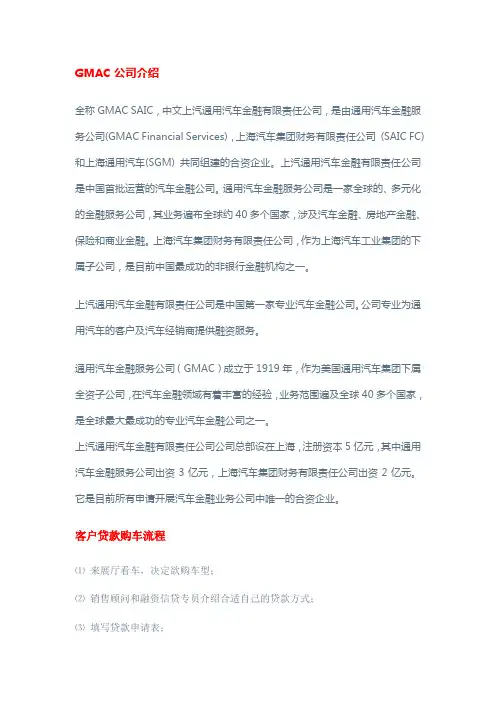
GMAC公司介绍全称GMAC SAIC,中文上汽通用汽车金融有限责任公司,是由通用汽车金融服务公司(GMAC Financial Services),上海汽车集团财务有限责任公司(SAIC FC) 和上海通用汽车(SGM) 共同组建的合资企业。
上汽通用汽车金融有限责任公司是中国首批运营的汽车金融公司。
通用汽车金融服务公司是一家全球的、多元化的金融服务公司,其业务遍布全球约40多个国家,涉及汽车金融、房地产金融、保险和商业金融。
上海汽车集团财务有限责任公司,作为上海汽车工业集团的下属子公司,是目前中国最成功的非银行金融机构之一。
上汽通用汽车金融有限责任公司是中国第一家专业汽车金融公司。
公司专业为通用汽车的客户及汽车经销商提供融资服务。
通用汽车金融服务公司(GMAC)成立于1919年,作为美国通用汽车集团下属全资子公司,在汽车金融领域有着丰富的经验,业务范围遍及全球40多个国家,是全球最大最成功的专业汽车金融公司之一。
上汽通用汽车金融有限责任公司公司总部设在上海,注册资本5亿元,其中通用汽车金融服务公司出资3亿元,上海汽车集团财务有限责任公司出资2亿元。
它是目前所有申请开展汽车金融业务公司中唯一的合资企业。
客户贷款购车流程⑴来展厅看车,决定欲购车型;⑵销售顾问和融资信贷专员介绍合适自己的贷款方式;⑶填写贷款申请表;⑷融资信贷专员核对贷款申请表信息;⑸GMAC信贷审核员电话拜访;⑹GMAC信贷审核员家访(此项并非每位客户都会有,根据客户资质而定);⑺融资信贷专员通知贷款申请结果,传真“签贷款合同通知书”与GMAC版本“收入证明”,根据上述内容准备签贷款合同资料;⑻申请人携配偶、担保人(如有)至4S店签定贷款合同;⑼GMAC放款,销售顾问开票、做保险、上牌;⑽申请人签定汽车抵押合同,将爱车驰回温馨的家。
还款方式⒈等额本息在此还款方式下,月还款金额保持不变(假定利率不变),即每月偿还的本息之和不变,但您每个月偿还的本金逐月增加,而利息则逐月减少。
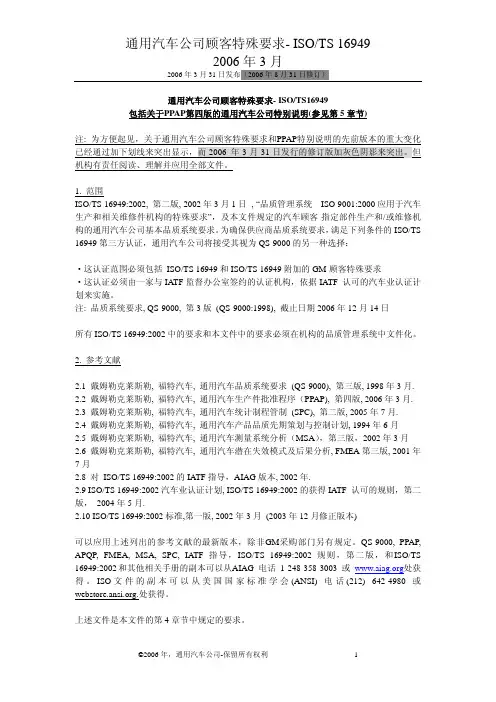
2006年3月31日发布(2006年8月31日修订)通用汽车公司顾客特殊要求- ISO/TS16949包括关于PPAP第四版的通用汽车公司特别说明(参见第5章节)注: 为方便起见,关于通用汽车公司顾客特殊要求和PPAP特别说明的先前版本的重大变化已经通过加下划线来突出显示,而2006 年3月31日发行的修订版加灰色阴影来突出。
但机构有责任阅读、理解并应用全部文件。
1. 范围ISO/TS 16949:2002, 第二版, 2002年3月1日 , “品质管理系统 –ISO 9001:2000应用于汽车生产和相关维修件机构的特殊要求”,及本文件规定的汽车顾客-指定部件生产和/或维修机构的通用汽车公司基本品质系统要求。
为确保供应商品质系统要求,满足下列条件的ISO/TS 16949第三方认证,通用汽车公司将接受其视为QS-9000的另一种选择:·这认证范围必须包括 ISO/TS 16949和ISO/TS 16949附加的GM-顾客特殊要求·这认证必须由一家与IATF监督办公室签约的认证机构,依据IATF 认可的汽车业认证计划来实施。
注: 品质系统要求, QS-9000, 第3版 (QS-9000:1998), 截止日期2006年12月14日所有ISO/TS 16949:2002中的要求和本文件中的要求必须在机构的品质管理系统中文件化。
2. 参考文献2.1 戴姆勒克莱斯勒, 福特汽车, 通用汽车品质系统要求 (QS-9000), 第三版, 1998年3月.2.2 戴姆勒克莱斯勒, 福特汽车, 通用汽车生产件批准程序(PPAP), 第四版, 2006年3月.2.3 戴姆勒克莱斯勒, 福特汽车, 通用汽车统计制程管制 (SPC), 第二版, 2005年7月.2.4 戴姆勒克莱斯勒, 福特汽车, 通用汽车产品品质先期策划与控制计划, 1994年6月2.5 戴姆勒克莱斯勒, 福特汽车, 通用汽车测量系统分析(MSA),第三版,2002年3月2.6 戴姆勒克莱斯勒, 福特汽车, 通用汽车潜在失效模式及后果分析, FMEA第三版, 2001年7月2.8 对 ISO/TS 16949:2002的IATF指导,AIAG版本, 2002年.2.9 ISO/TS 16949:2002汽车业认证计划, ISO/TS 16949:2002的获得IATF 认可的规则,第二版, 2004年5月.2.10 ISO/TS 16949:2002标准,第一版, 2002年3月 (2003年12月修正版本)可以应用上述列出的参考文献的最新版本,除非GM采购部门另有规定。
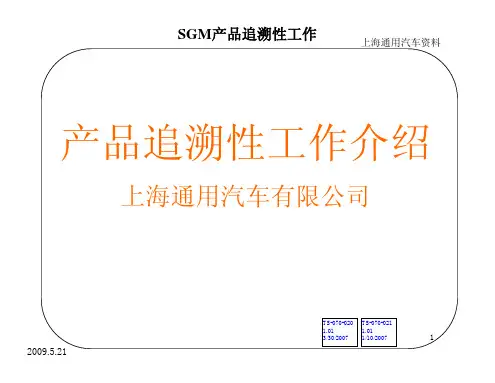
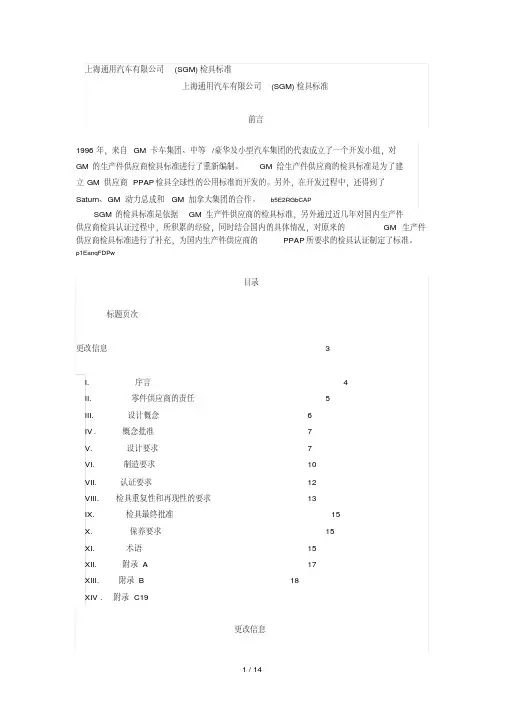
上海通用汽车有限公司(SGM)检具标准上海通用汽车有限公司(SGM)检具标准前言1996年,来自GM卡车集团、中等/豪华及小型汽车集团的代表成立了一个开发小组,对GM的生产件供应商检具标准进行了重新编制。
GM给生产件供应商的检具标准是为了建立GM供应商PPAP检具全球性的公用标准而开发的。
另外,在开发过程中,还得到了Saturn、GM动力总成和GM加拿大集团的合作。
b5E2RGbCAPSGM的检具标准是依据GM生产件供应商的检具标准,另外通过近几年对国内生产件供应商检具认证过程中,所积累的经验,同时结合国内的具体情况,对原来的GM生产件供应商检具标准进行了补充,为国内生产件供应商的PPAP所要求的检具认证制定了标准。
p1EanqFDPw目录标题页次更改信息3I. 序言4II. 零件供应商的责任5III. 设计概念6IV. 概念批准7V. 设计要求7VI. 制造要求10VII. 认证要求12VIII. 检具重复性和再现性的要求13IX. 检具最终批准15X. 保养要求15XI. 术语15XII. 附录 A 17XIII. 附录 B 18XIV. 附录C19更改信息版本日期段落条目1.0 12/1997 发布2.0 08/2002发布DXDiTa9E3d3.0 03/2005发布RTCrpUDGiT本标准中如发生任何更改都将记录在本页中。
当发生新的更改时,在保留本页清单原有记录的基础上,再增加新的更改内容。
修订后的版本将以版本 1.0、2.0、3.0的顺序发布。
当不同的版本发布时,通过参照段落和条目的相应内容,可迅速找出更改内容。
5PCzVD7HxA本文件替代下列文件:卡车和客车检具/量具标准(T& B 391)、12月、1989。
中等/豪华汽车集团检具设计/制造标准,4月,1996。
I. 序言A. 介绍依照上海通用汽车有限公司(SGM),先期产品质量策划手册(APQP)和生产件批准程序(PPAP)的要求,每当需要时,零件供应商应按照他们的质量计划获取检具来检验他们的产品。
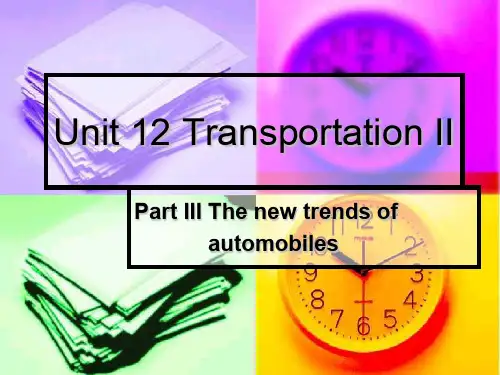
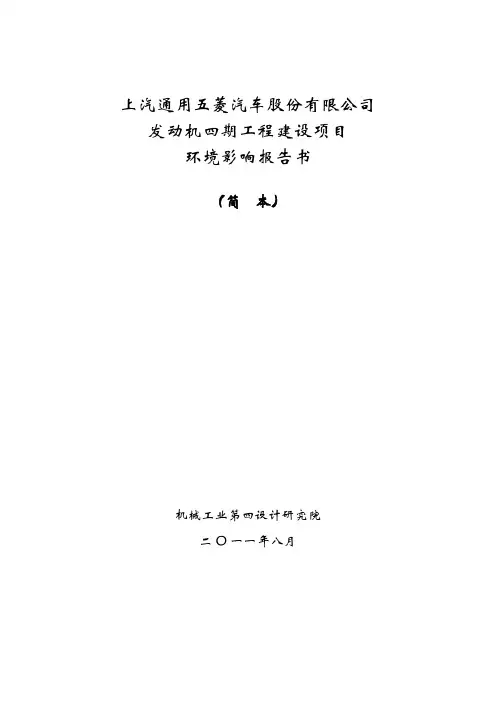
上汽通用五菱汽车股份有限公司发动机四期工程建设项目环境影响报告书(简本)机械工业第四设计研究院二O一一年八月1总论1.1项目由来近年来,国内汽车行业得到快速发展,产销量急剧增加,中国已成为继美国市场之后的世界第二大汽车消费市场,汽车工业的支柱产业地位已经基本形成。
上汽通用五菱汽车股份有限公司(以下简称上汽通用五菱)自2002年6月正式挂牌成立以来,利用合资各方的优势,继续保持以低价位车服务于个人汽车消费市场的特征,在微型汽车领域努力成为国内领先、国际上有竞争力的公司。
2007年起,连续4年产销量在微车行业位居第一。
2009年国家大力鼓励小排量汽车产品的投入市场,并进行了税制改革,给上汽通用五菱带来了新的机遇及动力。
2009年公司微车产量112.29万辆,销量106.51万辆,工业总产值350.7亿元。
为了不断满足市场的需求和国家排放法规,提高企业的竞争能力,上汽通用五菱拟实施柳州发动机四期工程建设项目,增加B系列产品多样性及性能,使产品开发上与整车保持同步,以实现公司未来发展目标。
项目位于柳州市官塘片区的上汽通用五菱乘用车基地,总投资为13.72亿,建成后将新增35万台/年的B系列发动机生产能力。
项目将沿用柳州发动机一期、二期、三项目的思路,不进行铸造等高污染的生产建设(铸件外协供应),只进行低污染的机加工和装配能力建设。
1.2污染因子的筛选与确定根据本项目的工程特征、污染物排放变化量、建设地区的环境特征,采用矩阵法对可能受该工程影响的环境要素进行识别筛选,得出评价的主要污染因子,择其对环境影响较大或为该工程的特征污染因子,确定切削液油雾、COD、SS、石油类、厂界噪声及敏感点噪声、废金属屑、污水处理污泥等为本次评价的预测因子。
1.3保护环境目标本项目所在区域内无文物古迹保护对象,主要环境保护目标为厂址周围的敏感点,其相对于本厂址的方位、距离及保护级别如表1-1《评价区内主要保护环境目标》所示。
通用汽车破产案例研究Study of General Motors bankruptcy case摘要:2009年六月一日,通用汽车正式宣布破产保护,这家著名的美国大公司终因严重的资不抵债而宣布破产保护。
从世界汽车界的领头羊到如今不得不依靠政府救助生存,其中有金融危机外在原因的影响,但最主要的还是通用公司的内部原因。
本文首先简单介绍了通用公司,在分析通用公司近期财务比率的基础上,试图找出这些原因。
ABSTRACT: On June 1, 2009, General Motors officially announced bankruptcy protection, this well-known large U.S. company was trapped in a serious insolvency. As the world leader in the automotive world past days now have to rely on government assistance to survive .Although this situation including the impact of external cause of the financial crisis, but the main reason is GM's internal problems. This article briefly describes the GM company and trying to find out the reason of bankruptcy by analysing financial ratios of this company.关键词:资不抵债金融危机通用公司财务比率KEY WORDS: Insolvency Financial crisis GM Company Financial Ratios一.案情简况拥有百年历史的通用汽车公司成立于1908年9月,曾是世界上最大的汽车制造企业。
上海通用(沈阳)北盛汽车有限公司校园招聘启事上海通用(沈阳)北盛汽车有限公司校园招聘启事上海通用(沈阳)北盛汽车有限公司(以下简称“上海通用北盛汽车”)成立于2004年8月2日,前身为金杯通用汽车有限公司,是由上海汽车股份有限公司、通用汽车中国公司、上海通用汽车有限公司(以下简称“上海通用汽车”)各投资25%、25%、50%股份兼并重组成立的中外合资企业,作为上海通用汽车制造基地,由上海通用汽车负责全面管理。
上海通用北盛汽车总投资56400万美元,注册资本22700万美元,公司占地面积41.3万平方米,建筑面积17.1万平方米,年生产整车能力20万辆,生产车型为别克GL8公务商务旅行车(年产能5万辆)与雪佛兰CRUZE 科鲁兹紧凑型性能轿车(年产能15万辆)。
作为上海通用汽车最年轻的制造基地,作为辽宁省最大的轿车生产基地,上海通用北盛汽车正处在不断发展、壮大的过程中,扁平的组织机构、充分的授权、全面的培养机制、迅速拓展的新业务及项目锻炼,为志向高远、渴望成功的杰出人才创造了充分施展才华的舞台和无限的发展空间,我们热切期待您和我们一起成长!公司地址:辽宁省沈阳市大东区北大营街15号联系电话:(024)88345683招聘信箱:hiring_sgmsy@招聘日程安排 城市 学校 日期时间 地点 内容 长春 长春工业大学3月10日14:00-17:00 综合三报告厅 宣讲、人事评估 3月11日 9:00-15:00 科研楼308.408.412教室专业面试专业需求、素质要求一、 专业需求:● 车辆工程● 机械类● 金属材料成型与控制(模具方向/焊接方向)● 高分子材料● 自动化/电气工程及其自动化● 化学工程与工艺● 内燃机/热能与动力工程● 电子、电器● 安全工程● 管理类(物流/人力资源)● 土木工程/路桥二、 素质要求:● 2011应届毕业生 本科 / 硕士;● 英语 CET-4 及以上, CET-6 优先;● 能够熟练掌握办公自动化软件,计算机二级及以上优先; ● 具备良好的团队合作精神和工作主动性;● 获得奖学金者优先;● 学生干部 / 党员优先。